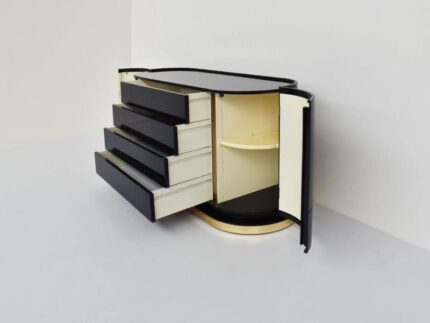Beautiful Inro, created in Japan during the Meiji imperial period, circa 1870. It was carefully crafted in carved precious wood with applications of lacquer and decorated with orientalism patterns. All dan trays are attached together with a himo cord. The detailed craftsmanship was a true pleasure to behold.
Period: Meiji 1868-1912, Period of Emperor Mutsuhito.
Approximate Date: 1870.
Motif: Organic design with cascade landscape scene and five flying cranes.
Drawers: Five.
Shape: Cylinder. Very unusual and rare shape.
Technique: Carved wood, Lacquer, hiramaki-e, takamaki-e, Gilding.
Ojime: 17mm, round with Ebony wood.
Netsuke: Carved dressed standing monk with a hat and holding a bag.
Weight: 46.60 Grams.
Measurements: Inro diameter of 30 mm, height of 78 mm (1.18 x 3.07 Inches)..
Meiji Period
This was an era of Japanese history that extended from October 23, 1868 to July 30, 1912.The Meiji era was the first half of the Empire of Japan, when the Japanese people moved from being an isolated feudal society at risk of colonization by Western powers to the new paradigm of a modern, industrialized nation state and emergent great power, influenced by Western scientific, technological, philosophical, political, legal, and aesthetic ideas. As a result of such wholesale adoption of radically different ideas, the changes to Japan were profound, and affected its social structure, internal politics, economy, military, and foreign relations. The period corresponded to the reign of Emperor Meiji. It was preceded by the Keiō era and was succeeded by the Taishō era, upon the accession of Emperor Taishō.
Inro
Is a traditional Japanese case for holding small objects, suspended from the obi (sash) worn around the waist when wearing a kimono. They are often highly decorated with various materials such as lacquer and various techniques such as maki-e, and are more decorative than other Japanese lacquerware. Because traditional Japanese dress lacked pockets, objects were often carried by hanging them from the obi in containers known as sagemono (a hanging object attached to a sash). Most sagemono were created for specialized contents, such as tobacco, pipes, writing brush and ink, but the type known as inro is suitable for carrying small things, and was created in the Sengoku period (1467–1615) as a portable identity seal and medicine container for travel. In the middle of the Edo period (1603–1868), inro became popular as men’s accessories, and wealthy merchants of the chōnin and samurai classes collected inro often beautifully decorated with lacquer. As the technique developed from the late Edo period to the Meiji period (1868–1912) and the artistic value of inro increased, inro were no longer used as an accessory and came to be regarded as an art object for collection.
Ojime: An ojime (緒締め), lit. is a bead cord fastener used in Japanese inrō (carrying cases). It is typically under an inch in length. Each is carved into a particular shape and image, similar to the netsuke, though smaller.
Netsuke: A netsuke (根付, [netsɯ̥ke]) is a miniature sculpture, originating in 17th century in Japan. Initially a simply carved button fastener on the cords of an inrō box, netsuke later developed into ornately sculpted objects of craftsmanship.
Collateral: This piece is accompanied by a presentation pouch.
Condition: The overall condition of this Inro is excellent. Beside the little normal wear, there is no damage to any part. All part are original and secured. This piece has been carefully inspected to guarantee the condition and authenticity.
INVENTORY REF: D070523RCEH/.1111
-
Dimensions:Height: 3.07 in (7.8 cm)Diameter: 1.18 in (3 cm)
-
Style:Meiji(Of the Period)
-
Materials and Techniques:Ebony,GiltwoodLacquerWoodGiltHand-CraftedLacquered
-
Place of Origin:Japan
-
Period:1870-1879
-
Date of Manufacture:1870
-
Condition:ExcellentWear consistent with age and use. The overall condition of this Inro is excellent. Beside the little normal wear, there is no damage to any part. All part are original and secured. This piece has been carefully inspected to guarantee the condition and authenticity.
-
Seller Location:Miami, FL
-
Reference Number:Seller: D070523RCEH/.1111Seller: LU8303235128022































Reviews
There are no reviews yet.